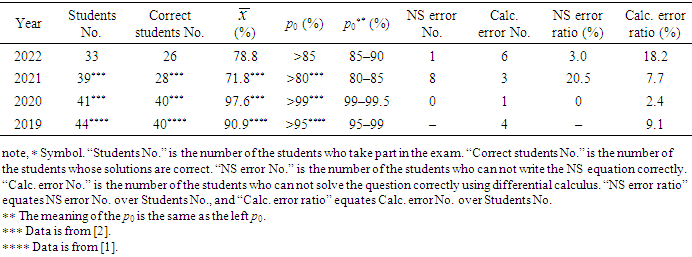-
Paper Information
- Paper Submission
-
Journal Information
- About This Journal
- Editorial Board
- Current Issue
- Archive
- Author Guidelines
- Contact Us
American Journal of Fluid Dynamics
p-ISSN: 2168-4707 e-ISSN: 2168-4715
2023; 13(1): 1-3
doi:10.5923/j.ajfd.20231301.01
Received: Apr. 10, 2023; Accepted: Apr. 25, 2023; Published: Apr. 27, 2023

One-Semester Effect on the Learning of the Navier-Stokes Equation
1Department of Engineering Mechanics, Shanghai Jiao Tong University, Shanghai, China
2Key Laboratory of Hydrodynamics of the Ministry of Education, Shanghai Jiao Tong University, Shanghai, China
Correspondence to: Shuxin Huang, Department of Engineering Mechanics, Shanghai Jiao Tong University, Shanghai, China.
| Email: |  |
Copyright © 2023 The Author(s). Published by Scientific & Academic Publishing.
This work is licensed under the Creative Commons Attribution International License (CC BY).
http://creativecommons.org/licenses/by/4.0/

The effect of studying the Navier-Stokes (NS) equation of undergraduate student is examined again in this work based on the exams in the recent four years from 2019 to 2022. Proportion test method is adopted in the research. A result shows that the students can remember the equation much better via one semester study than that via semi-semester study, which seems normal but conflicts the teaching plan of the fluid mechanics course including a midterm.
Keywords: NS equation, Study effect, Fluid mechanics, Inverse of the Stokes second problem, Hypothesis test, Exam, Undergraduate student, One semester study
Cite this paper: Shuxin Huang, One-Semester Effect on the Learning of the Navier-Stokes Equation, American Journal of Fluid Dynamics, Vol. 13 No. 1, 2023, pp. 1-3. doi: 10.5923/j.ajfd.20231301.01.
1. Introduction
- Two recent works [1,2] on the research of the study effect of the Navier-Stokes (NS) equation [3-7] indicate three conclusions. The first is that the inverse Stokes problem [5], i.e., the velocity of the second Stokes problem [6,8-10] is given and the question is to check the validity of the velocity for the NS equation and boundary conditions, is more suitable for student to study the NS equation. The second is that more than 80% students can use the NS equation properly at the end of the engineering fluid mechanics course of Huang [2], and the last is that web-home mode could have some merit for the learning of fluid mechanics. The experimental data that support the web-home mode of study was obtained in the spring of 2020, because there was an epidemic of COVID-19 in China and students studied at home via web teaching in the year. The high correctness of solving the inverse Stokes problem in 2020 [2] is attributed to four possible factors, i.e., some dishonest students, low error in calculation, superior study environment at home, and long-term study of the NS equation. It is difficult to check these factors formed in the special 2020.However, there occurred COVID-19 in Shanghai Jiao Tong University and in Shanghai in the spring of 2022, and we had to study and teach through web again. At the end of the course, the inverse Stokes problem was still employed to examine the study effect of the NS equation. The results are diversity accompanied by definite conclusion on the work, especially on the time used to study the equation.
2. Method
- The inverse Stokes problem can be found in the references [2,5]. The solution of the problem includes about three steps: (1) write out the NS equation; (2) calculate both the right and the left term of the equation using the given velocity and differential calculus, and then check if the right equates the left; (3) examine the boundary conditions using the given velocity.A statistic value Z [11] was employed to evaluate the correctness of exercising the NS equation,
 | (1) |
 is the correct ratio, n is the number of students.
is the correct ratio, n is the number of students.  is obtained by dividing the number of the students with correct answer by n. The significant level used for p0 is α = 0.05, which is also the same as that in [1,2]. Test for proportion is a standard statistical method.
is obtained by dividing the number of the students with correct answer by n. The significant level used for p0 is α = 0.05, which is also the same as that in [1,2]. Test for proportion is a standard statistical method.3. Results and Discussion
- Table 1 shows the examination on the study effect of the NS equation, where the data in 2022 is new and part of the data in the previous three years is new. There are two identical symbols p0 in Table 1, where the right can clearly indicate the range of the maximum correctness of solving the problem. For example, the maximum correctness in 2022 should be in the range of 85%–90%, which means that the maximum correctness is larger than 85% but lower than 90%. Moreover, there are two blanks in 2019, because students can see the NS equation in the exam and they were not required to remember the equation. In addition, solving the question correctly means that student only loses less than 5 score in the summation score of 20 of the question [1,2].
|
4. Conclusions
- The experience of examining the study effect of the NS equation of the author in 2022 affirms a conclusion that long-term study is beneficial to master the NS equation in the engineering fluid mechanics course. The result has conflict with the normal teaching plan, and canceling midterm could be an alternative teaching method for the course. The slightly high calculation error in 2022’s exam is a new phenomenon. The merit of the web-home mode in 2020 for study is still apparent in comparison with that of the web-school mode in 2022 for some students, which appears that the calculation capability of the students in 2020 seems superior to that in 2022.
Supplemental
- Supplemental material associated with this article can be found in the online version, at http://article.sapub.org/10.5923.j.ajfd.20231301.01.supplementa.pdf.
ORCID iDs
- Shuxin Huang, https://orcid.org/0000-0002-6878-664X.
 Abstract
Abstract Reference
Reference Full-Text PDF
Full-Text PDF Full-text HTML
Full-text HTML